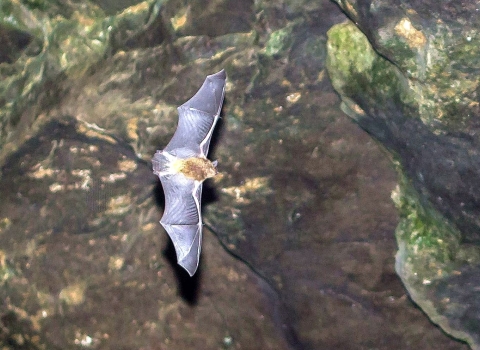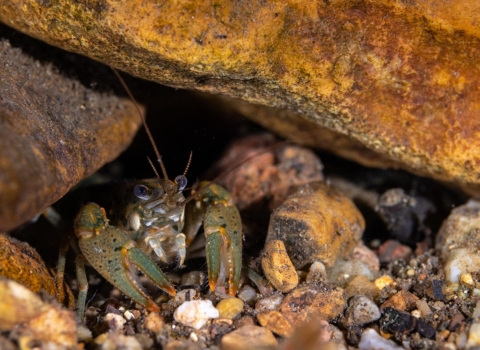What We Do
The Ecological Services Program is a leader in conserving our nations' imperiled species and their habitats, ensuring that sustainable populations of fish, wildlife and plants continue to thrive for future generations.
Section 7 Section 7
Section 7 Consultation
The Endangered Species Act (ESA) directs all Federal agencies to work to conserve endangered and threatened species and to use their authorities to further the purposes of the Act. Section 7 of the Act, called "Interagency Cooperation," is the mechanism by which Federal agencies ensure the actions they take, including those they fund or authorize, do not jeopardize the existence of any listed species.
Learn more about Section 7 Consultations
One way in which the Missouri Field Office fulfills the Ecological Services Program Mission is through Section 7 consultations under the U.S. Endangered Species Act (ESA). Through consultation, we work with partners and action agencies to avoid or reduce impacts to federally listed species and their habitats through the use of various options, including but not limited to in-lieu fee, conservation banking and permittee responsible programs.
When a private corporation looks to develop a forested wetland into a subdivision, for example, permits are required by various public agencies, including a review with our office. These projects are often good for the economy, but may have negative impacts to imperiled species. In order to enable progress, both economically and environmentally, projects are reviewed for impacts to federally listed species and their habitats and avoidance or mitigation measures are recommended. These may be facilitated through any of the options below.
Permittee Responsible Option
Applicants may choose to complete mitigation projects on their own, either through the restoration or protection of habitat, to offset impacts to federally listed species and their habitats.
Conservation Banking Option
For projects that impact multiple species, credits can be purchased at a USFWS-approved bank, often run by a for-profit consulting firm. The bank sponsor engages in mitigation projects up front, and sells credits for these projects until credits are gone. The bank takes on the liability of mitigation and ensures long-term stewardship and protection in perpetuity.
This program has resulted in approximately 200 acres of credit in Missouri, which have benefited the endangered Indiana bat, the threatened northern long-eared and little brown bats, a candidate species under review.
In-lieu Fee Program Option
For projects that impact Indiana bats in particular, permittees may work with a conservation nonprofit, The Conservation Fund (TCF), to mitigate the impacts of their projects on this endangered species. TCF coordinates with the permittees, who make a payment to TCF based on an appropriate mitigation ratio. Once payment is received and TCF issues a payment receipt, permittees have met their mitigation commitment for any potentially adverse effects their project may have on Indiana bats and their habitat. TCF then puts restoration or protection projects on the ground within two years of payment to offset these impacts and benefit Indiana bats.
This program has been particularly successful in protecting the Indiana bat in the state of Missouri. Out of all the states covered by the range-wide Indiana bat In-lieu fee program, Missouri leads the way with approximately 80% of the total balance.
This has resulted in over $2,117,000 for 341.5 acres of bat habitat protected in perpetuity throughout the state in the last four years alone, and is a great example of how routine regulatory work can result in great, on-the-ground conservation outcomes.
Management and Conservation
The Missouri Ecological Services Field Office strives to provide enduring resource benefits through strategic conservation actions that enable wetlands and critical habitats to persist, imperiled species to persevere and threats to be reduced such that species may be removed from federal protections throughout Missouri.
Our Projects and Research
Natural Resources Damage Assessment
The Missouri Field Office manages two very large mining sites, the Southeast Missouri Lead Mining District and Tri-State Mining District, that encompass multiple Superfund sites, thousands of acres of impacted land, and hundreds of miles of contaminated streams. The two mining districts make up the number one historic lead and zinc production areas in the nation, respectively. Managing these cases requires extensive coordination and collaboration with state partners, Department of the Interior Office of the Solicitor, U.S. EPA and the Department of Justice.
Outreach and Education
The Missouri Field office is dedicated to supporting conservation education across the state. Staff members often volunteer with partners at events to share the importance of conservation work, research, and partnerships. You can find our table at events such as Columbia Earth Day, Arrow Rock Birds, Bees and Blooms Festival, and many more. In 2023, the Missouri Field Office partnered with the U.S. Army Corps of Engineers to produce educational videos about bats, crayfish, and freshwater mussels. Those videos can be located in the Missouri Ecological Services Video Library.
Working closely with biologists and researchers from the U.S. Army Corps of Engineers St. Louis District, Missouri Department of Conservation and U.S. Geological Survey, we developed educational videos with several goals in mind.
- Introduce some of Missouri’s federally listed species
- Spotlight the people working to protect, conserve and recover federally listed species in Missouri
- Demonstrate how our agency and our partners study these animals
- Highlight conservation successes
- Share ways people can help protect and conserve species at home and in their communities.
Bats across North America are in decline, scientists across the globe strive to protect them. Our agency actively collaborates with federal, state and non-governmental partners to conserve and restore listed bat species. The full video series on bat conservation in Missouri can be accessed on YouTube.
Missouri's bats: flight to survival:...
There are more than 600 species of crayfish in the world, and about 400 in North America. Invasive species are negatively impacting ecosystems across the world, including crayfish habit Our agency actively collaborates federal, state and non-governmental partners to study and protect these aquatic invertebrates. The full video series on crayfish...
Freshwater mussels across the world, including Missouri, are increasingly threatened by habitat loss and degradation. Our agency actively collaborates with federal, state and non-governmental partners to study and protect these essential species. The full video series on freshwater mussel conservation in Missouri can be found on Youtube
...


